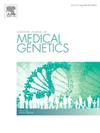两个兄弟姐妹中与 ITGB4 相关的幽门闭锁且无表皮松解症。
IF 1.7
4区 医学
Q3 GENETICS & HEREDITY
引用次数: 0
摘要
幽门闭锁是一种罕见的胃肠道畸形,在活产婴儿中的发病率为 1/100,000。幽门闭锁通常是一种孤立的病症,或与其他先天性或遗传性异常同时出现。由于 ITGA6、ITGB4 和 PLEC 基因的突变,幽门闭锁伴表皮松解症的致死性或非致死性常染色体隐性遗传变体已经为人所知。ITGB4 基因突变最近在两个与家族性孤立性幽门闭锁相关的家族中的 5 个兄弟姐妹中被发现。在此,我们介绍了两对患有幽门闭锁、ITGB4 基因同源变异且无表皮松解症的兄弟姐妹。由于 ITGB4 基因的同源变异,可能会出现孤立性家族性幽门闭锁,但不伴有表皮松解症。该基因中更多变异的检测可能有助于建立基因型与表型之间的相关性,并可能提示ITGB4基因在患有幽门闭锁而无表皮松解症的患者中的作用。本文章由计算机程序翻译,如有差异,请以英文原文为准。
ITGB4-Related pyloric atresia without epidermolysis in two siblings
Pyloric atresia is a rare gastrointestinal anomaly with an incidence of 1/100,000 in live births. It is usually seen as an isolated condition or in combination with other congenital or hereditary anomalies. Autosomal recessive inherited either fatal or non-fatal variants of pyloric atresia with epidermolysis bullosa are known due to mutations in ITGA6, ITGB4, and PLEC genes. ITGB4 gene mutation was recently identified in 5 siblings in 2 families associated with familial isolated pyloric atresia. Herein, we present two siblings who had pyloric atresia together with a homozygous variant in the ITGB4 gene and without epidermolysis bullosa. The development of isolated familial pyloric atresia without epidermolysis bullosa may occur due to homozygous variants of the ITGB4 gene. Detection of more variants in this gene may help to establish a genotype-phenotype correlation and may suggest the ITGB4 gene in patients who have pyloric atresia without epidermolysis bullosa.
求助全文
通过发布文献求助,成功后即可免费获取论文全文。
去求助
来源期刊
CiteScore
4.10
自引率
0.00%
发文量
193
审稿时长
66 days
期刊介绍:
The European Journal of Medical Genetics (EJMG) is a peer-reviewed journal that publishes articles in English on various aspects of human and medical genetics and of the genetics of experimental models.
Original clinical and experimental research articles, short clinical reports, review articles and letters to the editor are welcome on topics such as :
• Dysmorphology and syndrome delineation
• Molecular genetics and molecular cytogenetics of inherited disorders
• Clinical applications of genomics and nextgen sequencing technologies
• Syndromal cancer genetics
• Behavioral genetics
• Community genetics
• Fetal pathology and prenatal diagnosis
• Genetic counseling.

 求助内容:
求助内容: 应助结果提醒方式:
应助结果提醒方式:


